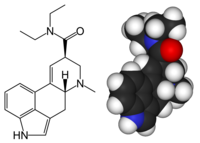
Lysergide
Lysergide (LSD) drug profile
Family: Tryptamines ?
it's an ergoline, with either a tryptamine or phenethylamine group, depending on how you look at it. it has much higher affinity for the 5HT subtypes, indicating the tryptamine functional group is probably more relevant on its mode of action (it actually acts on several neurotransmitter systems)
LSD stands for Lysergic Acid Diethylamide (Lysergsurediethylamid in German). Its psychedelic properties were discovered 1943 by Swiss chemist Albert Hofmann. It received significant attention in the U.S. throughout the 1960s in the cultural revolution and peace movement during the time of the Vietnam War, with proponents such as Harvard Professor Timothy Leary, Stanislav Grof, and John C. Lilly believing in its potential for psychotherapy. It was quickly criminalized, however, making research with it either impossible or illegal. It is often als refered to simply as acid.
LSD is chemically related to DMT and Psilocybin/Psilocin but is active in far more minuscule amounts. Usual forms in which LSD can be found are blotter (pieces of paper onto which dissolved LSD is dropped), liquid, or powder/crystals (very rare). The most common form of administration is sublingual.
Symptoms:
| Low Dose | Medium Dose | High Dose |
| Pupils slightly dilated, slight trembling, slurred speach | Pupils greatly dilated, slurred speach, incoherency, trembling | Pupils greatly dilated, strong incoherence (in- ability to form sentences), trembling and shaking, cold hands and feet, sweating, |
Symptoms:
| Low Dose | Medium Dose | High Dose |
| Colors appear brighter, edges sharper. Light- headedness, muscle tension, nervousness. Altered thought-processes / in- ternal dialog. Closed-eye visuals (patterns, colors) | (Geometric) patterns ap- pear on uniform surfaces, walls seem to be breath- ing. Patterns and struc- tures may seem to shift or move. Things may appear novel or more wondrous, events more intense. Diffi- culty in understanding how things work ((e.g. Comput- ers, phones, etc.). Diffi- culty in following conversa- tions. Thought loops. Loss of a feeling for time. Intensi- fication of preexisting emo- tions. Closed eye visions. Euphoria. | Geometric 3-dimensional patterns appear, difficulty in focusing the eyes, synesthe- sia, Visions, Intensification of emotions, insights, time dialation, inability to tell which position the body is in, mystical experiences, |

